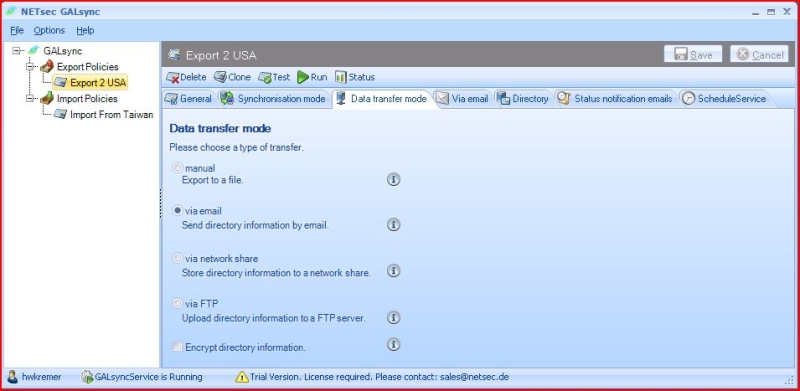GALsync
- Category
- Network and Internet
- Mail Server Tools

- Developer: NETsec GmbH & Co. KG
- Home page: www.netsec.de
- License type: Commercial
- Size: 8.83 MB
- Download
Review
Usability scenarios * Company Splitted Active Directory model Your company has one internal Active Directory and one separate Active Directory for company's sales representatives. You want all user objects and groups of the sales reps AD to be visible to your internal Outlook/Exchange users (using the Global Address List). Vice versa: You want all sales reps have access to information of a subset of the internal users. * Company take-over Because of a company take-over you have to integrate different Active Directories and Exchange organizations. You have to share all or subsets of all user and group information for Outlook/Exchange users in the Global Address List. *Company & Partners Your company has a partner company and you want to share some user and group information for Outlook/Exchange users in the Global Address List. *Migration Your company wants to migrate to a new Exchange organization. You have to ensure that all migrated users may send messages to users in the original organization and vice versa. Features included *Choose the objects you need Select all objects or subsets of objects to export to the other AD. While GAL Sync is used for Outlook/Exchange it will only consider mail-enabled objects. *Multiple-Domains Select objects in any of the domains in your forest to export. GAL Sync is cross-domain capable. *Choose your Transmission Protocol GALsync allows you an integrated handing-over of the selected information to the other Active Directory by using a Windows Share, by FTP or by SMTP. *Secure Data Transmission Data are transmitted encrypted between the different Active Directories. So no one can read your object's details during the transmission from source to target. *Managed Code GAL Sync is written in managed code using .NET framework 2.0. It can run on 32 or 64bit Windows platforms. *Log Files Log files are created so you can track exactly what happened.